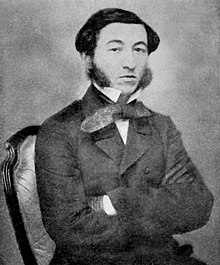
Back مايكل نالبانديان Arabic ميكايل نالبانديان ARZ Mikael Nalbandyan Azerbaijani میکائیل نالباندیان AZB Mikael Nalbandian Catalan Mikajel Nalbandjan Czech Mikael Nalbandian German Mikael Nalbandjan Esperanto Mikael Nalbandian Spanish Mikael Nalbandjan Estonian
Mikayel Nalbandian | |
|---|---|
 | |
| Born | 14 November [O.S. 2 November] 1829 Nakhichevan-on-Don, Don Host Oblast, Russian Empire |
| Died | 12 April [O.S. 31 March] 1866 (aged 36) Kamyshin, Saratov Governorate, Russia |
| Resting place | Holy Cross Armenian Church, Rostov-on-Don |
| Occupation |
|
| Language | Modern Eastern Armenian |
| Nationality | Armenian |
| Education |
|
| Genre |
|
| Subjects |
|
| Literary movement | Realism |
| Years active | 1851–1866 |
| Notable works |
|
| Signature | |
 | |
Mikayel Nalbandian[a] (Armenian: Միքայել Նալբանդյան; 14 November [O.S. 2 November] 1829 – 12 April [O.S. 31 March] 1866) was a Russian-Armenian writer, poet, political theorist and activist.
Nalbandian was born in Nakhichevan-on-Don, an Armenian town in southern Russia, and traveled extensively, although he visited Armenia itself only once. A radical intellectual, Nalbandian was an avid advocate of secularism and anti-clericalism, the use of modern Armenian (as opposed to classical Armenian) and a vocal critic of the conservative clergy of the Armenian Apostolic Church. He also espoused anti-Catholicism. Inspired by the Enlightenment and the Italian unification, Nalbandian advocated reform, cultural nationalism and agrarianism among Armenians. In his later years he was influenced by Russian radicals such as Alexander Herzen and Nikolay Chernyshevsky. For his association with them, he was persecuted and died in exile at 37.
A champion of modernism, he is seen as a follower of Khachatur Abovian. In turn, he influenced many others, including the novelist Raffi, Armenian nationalist revolutionaries (especially the Dashnaks), and Armenian Marxists, such as Alexander Miasnikian. Nalbandian was widely revered in the Soviet period, while Dashnaks adopted "Mer Hayrenik", based on his poem "The Song of an Italian Girl", as the anthem of the First Republic of Armenia in 1918. It was re-adopted by independent Armenia in 1991. Another poem by Nalbandian, glorifying freedom, has become a celebrated anthem since it was written in 1859.
- ^ a b Hacikyan et al. 2005, pp. 292–293.
- ^ a b Daronian 1974, p. 225.
- ^ Inchikian 1954, p. 31.
- ^ Inchikian 1954, pp. 68, 224–5.
- ^ Cite error: The named reference
Blackwellwas invoked but never defined (see the help page). - ^ Cite error: The named reference
Dadrianwas invoked but never defined (see the help page).
Cite error: There are <ref group=lower-alpha> tags or {{efn}} templates on this page, but the references will not show without a {{reflist|group=lower-alpha}} template or {{notelist}} template (see the help page).
© MMXXIII Rich X Search. We shall prevail. All rights reserved. Rich X Search